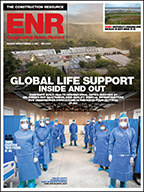Citing a crucial need for a coordinated approach to resilient rebuilding in Hurricane Sandy-affected areas, the U.S. Dept. of Housing and Urban Development Secretary Shaun Donovan announced the creation of a HUD-led regional forum to "understand interdependencies and interconnections." Construction industry leaders agree that, if anyone can provide the mortar between disparate constituencies in Sandy-affected areas, it is Donovan.
"An effective and charismatic convener such as Secretary Donovan knows how to get people to the table," says Rick Bell, executive director of AIA New York (AIANY). "Too often, New York and New Jersey fail to come together because their governors have ideological differences or political ambitions."
Bomee Jung, deputy director of the New York City office of affordable housing developer Enterprise Community Partners, agrees that "HUD should play the quarterback role."
Task-Force Recommendations
The regional forum is one of 69 strategies that was laid out on Aug. 19 by President Obama's Hurricane Sandy Rebuilding Task Force in its nearly 200-page "Hurricane Sandy Rebuilding Strategy." "Many of the recommendations are already in place," says Donovan, the task-force chairman.
The multi-agency group, which convened with local, state, regional, national and private stakeholders, takes a holistic view of resilient rebuilding and offers ways to streamline processes and align plans for climate adaptation. The strategies take into account green infrastructure, affordable insurance, permitting, legislative changes, infrastructure finance and housing.
"The rebuilding strategy shows the best of what the federal government can do: coordinate multiple federal, state, county and municipal agencies; streamline oversight and permitting; and deliver federal funds where they are needed most," says Richard T. Anderson, president of the New York Building Congress (NYBC).
The strategies will guide use of the rest of the $50 billion of post-Sandy supplemental congressional funding. One recommendation—to prioritize all large-scale infrastructure projects and map their connections and interdependencies—will have a big impact on federal funding, says the report.
The task force also crafted seven federal infrastructure guidelines so that post-Sandy projects are built to withstand the impacts of climate change. One recommendation is to apply the guidelines nationally.
Each recommendation includes an action plan, a status report and a designated ownership by a government agency. Projects should result from collaborations "across all levels of governance and the private sector to produce a regional and cross-jurisdictional approach," says the report.



Post a comment to this article
Report Abusive Comment